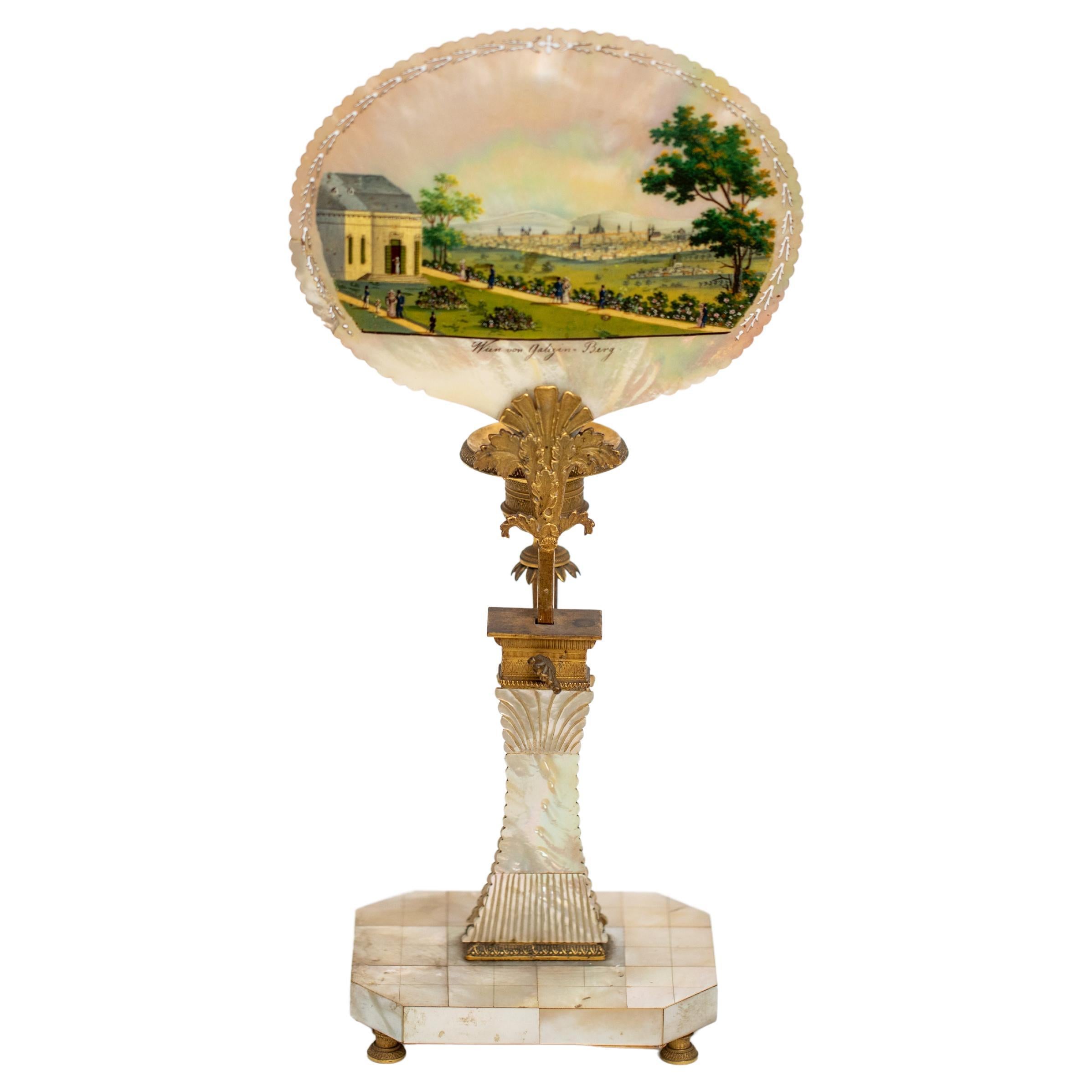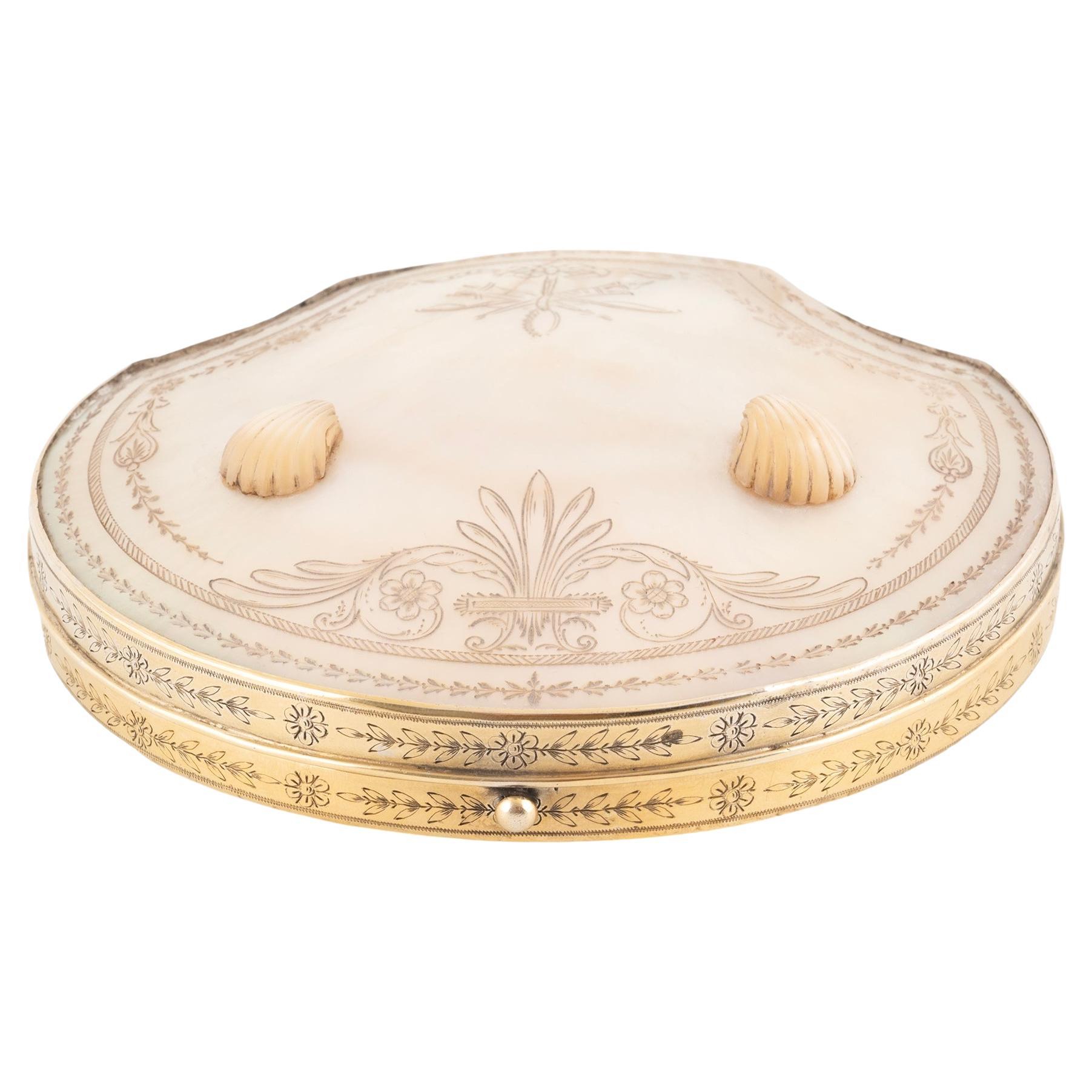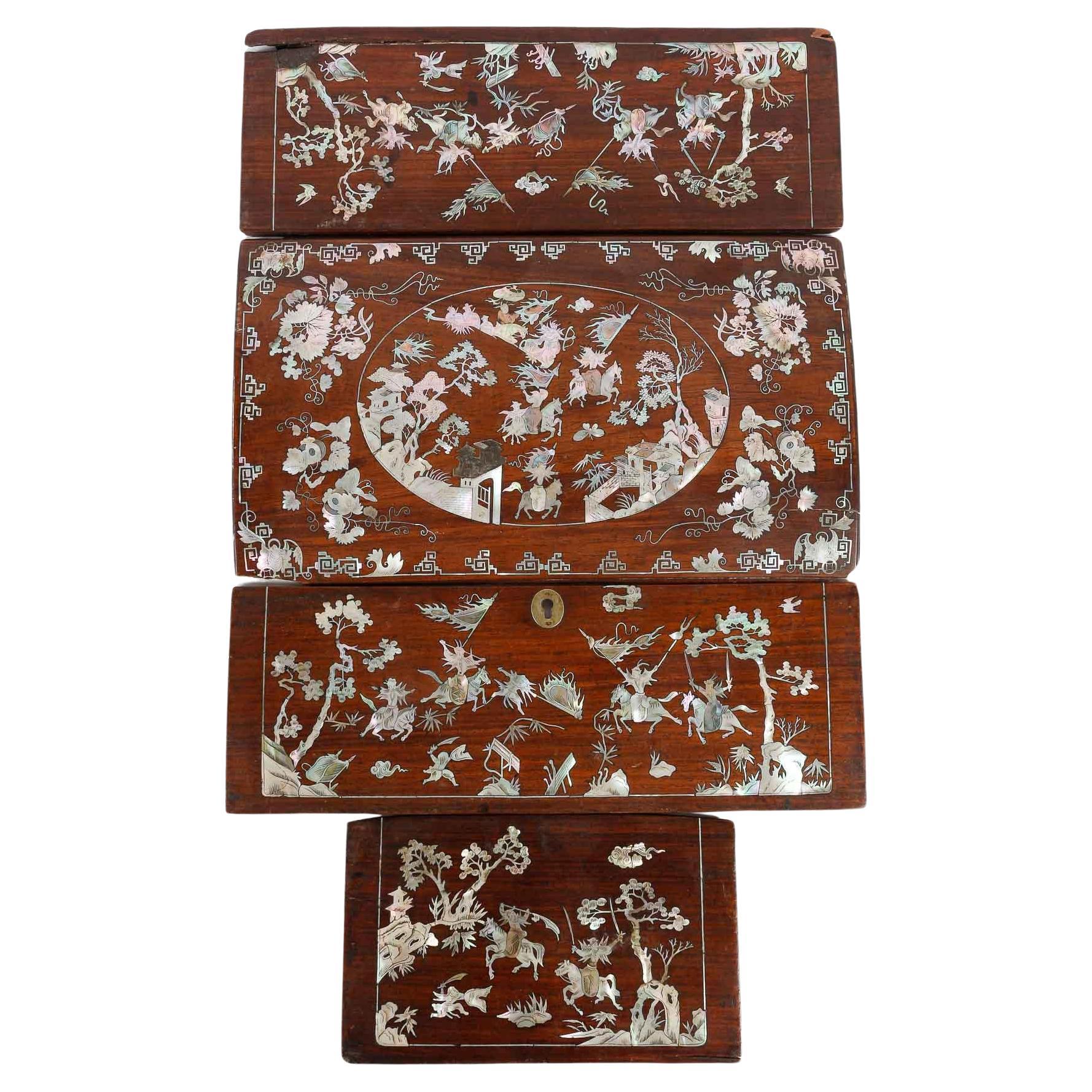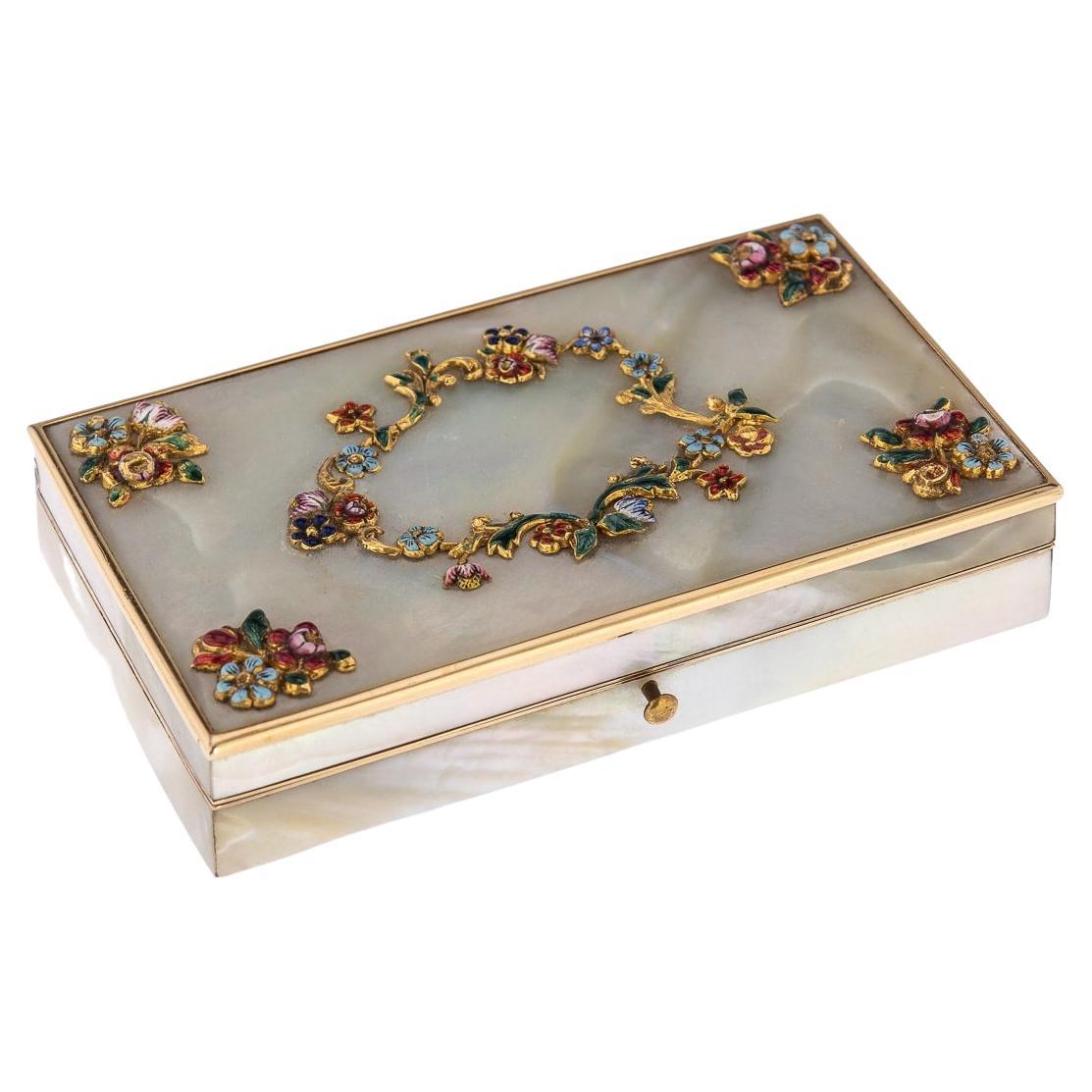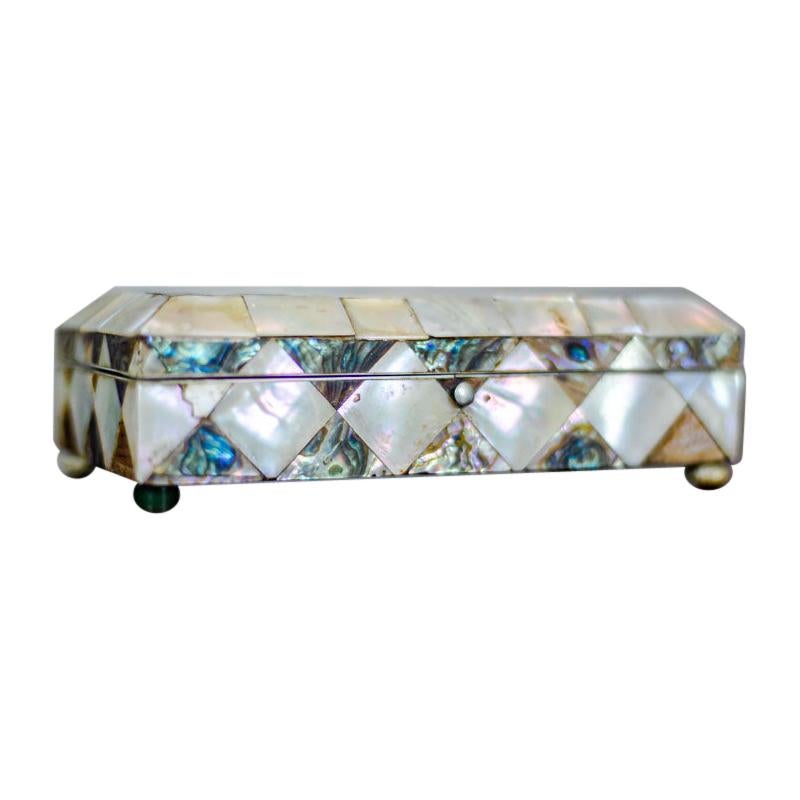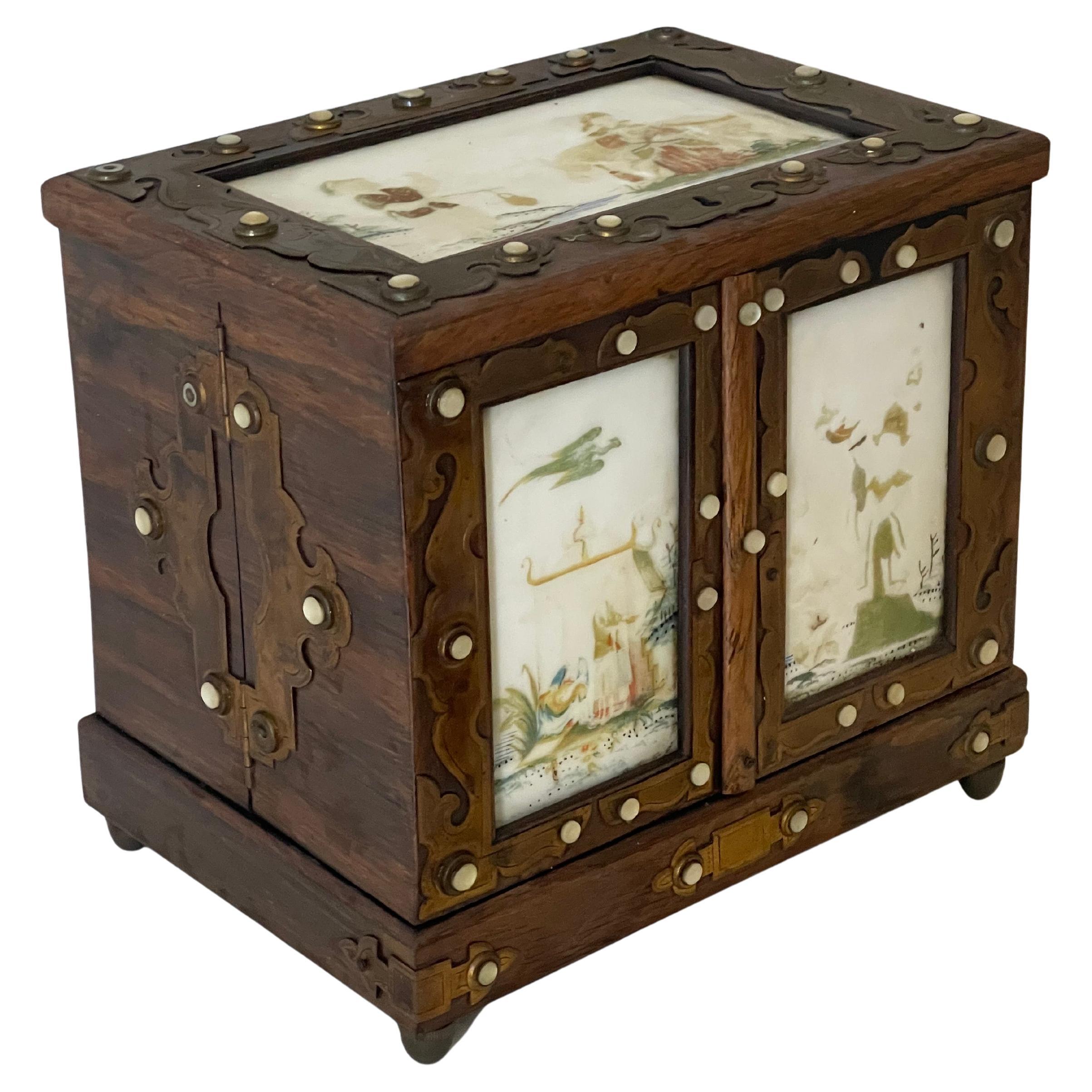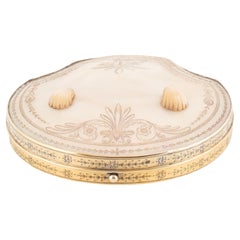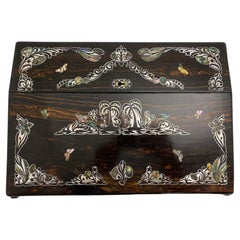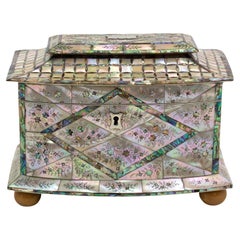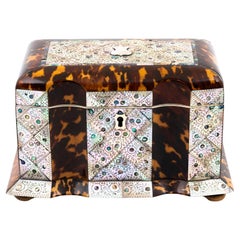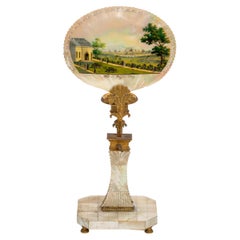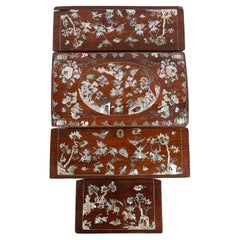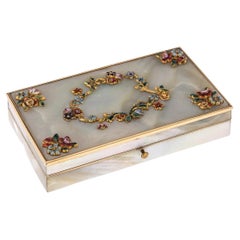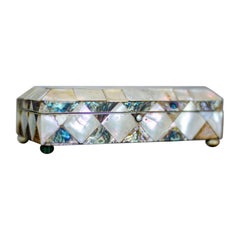Artículos similares a Austrian Mother of Pearl Etui with London Scene by Balthasar Wigand
¿Quieres más imágenes o vídeos?
Solicita imágenes o vídeos adicionales al vendedor
1 de 11
Austrian Mother of Pearl Etui with London Scene by Balthasar Wigand
18.474,96 €
Envío
Recuperando presupuesto…La promesa de 1stDibs
Garantía de autenticidad,
Garantía de devolución de dinero,
Cancelación dentro de las 24 horas
Acerca del artículo
Fully Fitted Sewing Box
From our Sewing Box collection, we are delighted to introduce to the market this exceptional Mother of Pearl Sewing Box with painted panel by Balthasar Wigand. The Sewing Box of slimline rectangular form with a raised lid beautifully finished with a quilted mother of pearl exterior, a shaped ormolu escutcheon and glazed panel featuring a painted gouache rectangular scene depicting Saint Pauls Cathedral and the river Thames, London which is without doubt attributed to Balthasar Wigand. When opened the Sewing Box features a fully fitted and original sewing kit with mother of pearl tools and accessories with gold mounts and an inner mirror with red rope work. The Austrian Mother of Pearl Sewing Box painted panel is firmly attributed to Balthasar Wigand (1770-1846) and the box to Karl Schmid who was a renowned manufacture of mother of pearl novelties see references below. The Austrian Mother of Pearl Sewing Box dates to the early 19th century circa 1820 and was likely retailed in the famous Palais Royal in France.
Reference The New York Met Accession Number 1990.328.21a–i, the London Royal Collection Inventory number RCIN 3487 , the Victoria & Albert Museum Accession Number W.12-1977, Liechtenstein The Princely Collections Inventory number GR 649 and SK 927
Literature Mark Goodger 25th Anniversary Catalogue page 33
Karl Schmid (fl. first half of the 19th century) won a bronze medal for mother-of-pearl novelties at the first Austrian Industrial Products Exhibition held in 1835. Karl Schmid, who was noted as a turner, was celebrated for his work in mother-of-pearl.
Balthasar Wigand (1770-1846) was an austrian born painter who specialised in gouache views of famous Viennese sites and buildings. He was born in 1770 as the son of a Viennese coffee roaster and graduated at the Academy of Fine Arts. He moved onto concentrate on the genre of miniature painting which he perfected over time. Specialising in small formats, his works focused mainly on the depiction of political events (such as processions) in the Napoleonic era, as well as on shaded city vedutas and landscape sceneries of his home region. His watercolours and gouaches were highly popular, and the artist was never short of new commissions. Wigand opened a workshop to meet the rising demand, where everyday objects such as sewing caskets, were decorated with his miniature paintings.
Palais Royal is the collective name of objects that were sold within a Palace in Paris. Originally it was built for Cardinal Richelieu in 1629 and was originally named Palais Cardinal but after the death of Richelieu, it was inherited by King Louis XIII and was named Palais Royal. The palace was later bequeathed to Philippe d’Orléans, a cousin of Louis XVI and in 1781, Philippe d’Orléans, on the verge of financial ruin, decided to subdivide the Palais Royal Garden, which until then had been free of any dwelling. Construction took five years, after which 90 merchants moved in. The area was a popular place for loiterers, betters, pickpockets, and prostitutes. When the revolution ended in 1799 the Palais Royal was refurbished again by Napoleon Bonaparte when he became Emperor in 1804 and it housed galleries and shops selling high quality luxury wares such as this notebook above. It again fell into disrepair when gambling was banned in 1838 but restored in the 1870s. Due to this, there are very few if any pearl Palais Royal objects crafted after 1840.
Mother of Pearl, Mother of pearl is an organic-inorganic composite material produced by some molluscs as an inner shell layer. It is the same material that natural pearls are made from and is desirable due to its strong and resilient makeup along with its beautiful iridescent shimmer.
- Dimensiones:Altura: 4,5 cm (1,78 in)Anchura: 12 cm (4,73 in)Profundidad: 8,5 cm (3,35 in)
- Materiales y técnicas:
- Lugar de origen:
- Época:
- Fecha de fabricación:Circa 1820
- Estado:
- Ubicación del vendedor:Northampton, GB
- Número de referencia:Vendedor: 5015841stDibs: LU8027245480522
Sobre el vendedor
Aún no hay opiniones
Vendedor profesional aprobado
Todos los vendedores superan estrictas normas de autenticidad y confiabilidad
Establecido en 1998
Vendedor de 1stDibs desde 2023
30 ventas en 1stDibs
Tiempo de respuesta usual: 4 horas
- EnvíoRecuperando presupuesto…Envío desde: Northampton, Reino Unido
- Política de devolución
Partes de esta página se han traducido automáticamente. 1stDibs no puede garantizar la exactitud de las traducciones. El inglés es el idioma predeterminado de este sitio web.
Garantía de autenticidad
En el improbable caso de que haya algún problema con la autenticidad de un artículo, ponte en contacto con nosotros en un plazo de 1 año para recibir un reembolso total. DetallesGarantía de devolución de dinero
Si tu artículo no es como se describe, sufre daños durante el transporte o no llega, ponte en contacto con nosotros en un plazo de 7 días para recibir un reembolso total. DetallesCancelación dentro de las 24 horas
Tienes un período de gracia de 24 horas para reconsiderar tu compra, sin preguntas.Vendedores profesionales aprobados
Nuestros vendedores de primera clase deben cumplir estrictos estándares de servicio para mantener la integridad de nuestros anuncios.Garantía de igualación de precios
Si encuentras que un vendedor publicó el mismo artículo por un precio menor en otro lado, igualaremos ese precio.Entrega global de confianza
Nuestra red de transporte de primera ofrece opciones de envío especializado en todo el mundo, que incluye envío personalizado.Más de este vendedor
Ver todoAntique French Palais Royal Mother of Pearl Clam Necessaire Etui
Por Palais Royal
Mother of Pearl and Ormolu
From our Sewing collection, we are delighted to offer this Palais Royal Necessaire Etui. The Etui of rare clam shell shape framed in ormolu with engraved...
Categoría
Antiguo, principios del siglo XIX, Francés, Cajas decorativas
Materiales
Latón
Pendiente de escritura victoriana antigua de Coromandel y nácar de Richard Wathew
Por Richard Wathew
Incrustación de nácar
De nuestra colección de cajas de escritura, estamos encantados de ofrecerte esta Pendiente de escritura victoriana de Coromandel y nácar de Richard Wathew. La ...
Categoría
Antiguo, Mediados del siglo XIX, Inglés, Victoriano temprano, Cajas deco...
Materiales
Cuero, Caparazón, Madera
Caja de Té Georgiana Antigua de Nácar con Frente de Arco
Regencia Circa 1820
De nuestra colección Tea Caddy, estamos encantados de introducir en el mercado este Tea Caddy con frente de lazo de nácar. La caja para el té tiene una hermosa f...
Categoría
Antiguo, principios del siglo XIX, Inglés, Regencia, Cajas de té
Materiales
Caparazón
Caja de té de serpentina de carey y nácar de la Regencia
Con paneles alternos
De nuestra colección de Cajas de Té, estamos encantados de ofrecerte esta fina Caja de Té de Serpentina de carey y nácar de la Regencia. La caja para el té, de ...
Categoría
Antiguo, principios del siglo XIX, Inglés, Regencia, Cajas de té
Materiales
Caparazón de tortuga, Nácar
Caja de escritura inglesa antigua de nácar y palisandro Hausburg
Por F.L. Hausburg
Atribuido firmemente a Hausburg
De nuestra colección de cajas de escritura, nos complace ofrecer esta antigua caja de escritura victoriana atribuida a Hausburg. La Caja de Escritura...
Categoría
Antiguo, Mediados del siglo XIX, Inglés, Victoriano, Cajas decorativas
Materiales
Peltre
Antiguo joyero inglés victoriano de coromandel y nácar
Victoriana Circa 1875
De nuestra colección de joyeros, nos complace ofrecerte este impresionante joyero de Coromandel y nácar. El joyero, de forma rectangular, está bellamente chapa...
Categoría
Antiguo, Fines del siglo XIX, Inglés, Alto victoriano, Joyeros
Materiales
Caparazón, Madera
También te puede gustar
Pantalla de candelabro Viena del siglo XIX de Balthasar Wigand Madreperla
Pantalla o candelabro de madreperla de Balthasar Wigand Viena hacia 1810-1820 con pintura muy fina del Galitzerberg de Viena.
Balthasar Wigand nacido en 1771 vivió y trabajó en una...
Categoría
Antiguo, Década de 1810, Austríaco, Imperio, Apliques para velas
Materiales
Bronce
4 Paneles de una Caja de Madera con Incrustaciones de Madreperla, Escenas Chinas.
4 Paneles de una Caja de Madera con Incrustaciones de Madreperla, Escenas Chinas, Siglo XIX.
4 paneles de una caja de madera con incrustaciones de nácar que representan escenas chin...
Categoría
Antiguo, siglo XIX, Chino, Chinoiserie, Cajas decorativas
Materiales
Madera
Juego de etui francés del siglo XIX, montado en oro y madreperla, c.1870
Antiguo Siglo XIX Juego etui francés de oro montado sobre madreperla, de extenso viaje, de forma octogonal alargada, el oro montado con paneles de madreperla pulida y la tapa aplicad...
Categoría
Antiguo, siglo XIX, Francés, Cajas decorativas
Materiales
Oro
Cofre del siglo XIX con madreperla
Te presentamos un cofre bajo de madera, cuya superficie está recubierta de azulejos de nácar en forma de rombo.
Este artículo es del tercer trimestre del siglo XIX.
El nácar se com...
Categoría
Antiguo, Fines del siglo XIX, Europeo, Cajas decorativas
Materiales
Nácar, Terciopelo, Plástico
424 € Precio de venta
Descuento del 29 %
Antigua Caja China de Chinoiserie con Nácar
Antigua caja china de madera Chinoiserie con inserciones pintadas a mano. Botones decorativos de nácar. Puertas laterales dobles con compartimentos para pequeñas esculturas. Gran pieza.
Categoría
Antiguo, Principios del 1900, Chino, Chinoiserie, Cajas decorativas
Materiales
Madera
Caja de té de carey con incrustaciones de nácar
Caja de té de carey con incrustaciones de nácar procedente de Inglaterra. Forrado de metal bajo dos tapas. Excelente estado, hacia 1860.
Categoría
Antiguo, Década de 1860, Inglés, Cajas de té
Materiales
Caparazón de tortuga, Nácar
